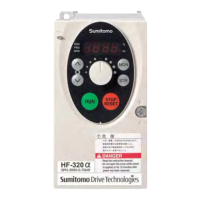Control without sensor . . . . . . .dVector control is conducted without using a sensor (PG, etc. for speed feedback
control). This method improves the motor speed accuracy and torque characteristics
from the low to high frequency band better than the V/F control does. Since the
control is based on the motor constant, this control method is applicable when one
motor is connected to one inverter.
V/F control . . . . . . . . . . . . . . .The V/F (voltage/frequency) is maintained constant for a motor. The motor speed
accuracy and torque characteristics are inferior to the control without a sensor that
stabilizes the magnetic flux. However, unlike the control without a sensor, more than
one motor can be connected to one inverter.
Torque boost . . . . . . . . . . . . . .The loss of output torque due to the voltage drop inside the motor is compensated for
under the V/F control. Under the control without a sensor, the torque boost is
automatically controlled according to the load, so boost setting is unnecessary.
Auto-tuning . . . . . . . . . . . . . . .The inverter automatically measures and saves the motor constant that is necessary
for control without a sensor. The motor constant of our motors are already saved in
the inverter. Just select the model of the motor, and auto-tuning is unnecessary.
(Tune the wiring resistance when it is long.)
Energy-saving mode . . . . . . . .Energy loss is controlled by reducing the motor flux when the load is light. The
parameter Pt is used for setting.
Base frequency . . . . . . . . . . . .Boundary point between the constant torque characteristic area and constant output
characteristic, which is usually 50 or 60 Hz.
Stall prevention . . . . . . . . . . . .The output frequency is controlled in order to prevent a stall (loss of motor speed) and
overcurrent error even if the output current increases when the acceleration time is
short or a load is heavy. When this function is activated or overcurrent is generated, it
is necessary to reexamine the capacity of the motor and inverter.
Electronic thermal relay . . . . . .A function identical to the thermal relay for protection of the motor from overloading is
incorporated in the inverter. Since the electronic thermal relay is not affected by high-
frequency, it protects more accurately than a thermal relay. However, when more than
one motor is connected to one inverter, install a thermal relay individually for
respective motors. The characteristics of the electronic thermal relay is slightly
different from that of thermal relays because the condition of temperature around the
motor is not included.

